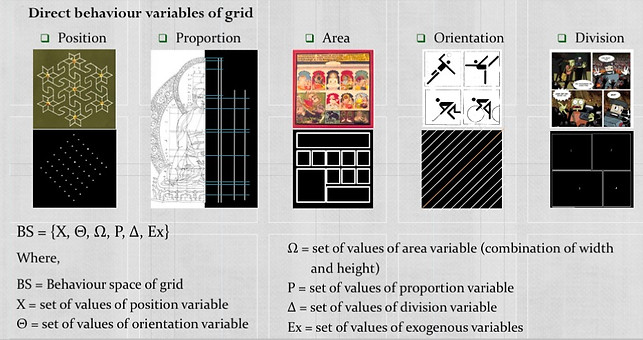Design Research

Visual Language
Knowledge representation
Design Semiotics
Typography
Game Design

KNOWLEDGE REPRESENTATION OF GRIDS IN GRAPHIC DESIGN
In this thesis, the tacit knowledge about grids is externalised, articulated and represented in an abstract framework. The support for knowledge representation and knowledge transfer can improve the implicit knowledge of designers and hence may enhance the quality of design practice. A common ‘knowledge representation system’ is required for knowledge transfer across distant domains.
The ontological framework of Function-Behaviour-Structure [FBS] (Gero, 1990) (Gero & Kannengiesser, 2002), which has been proved very useful to explain the process of design, is used here as the foundation to develop the representation of grids in action. Here, grid is treated as a designed object created by the designer to assist in visual design. FBS path of the formation of a grid is found to be nested within the FBS path of image creation. This representation is further elaborated by defining the function variables, behaviour variables and structure variables. The knowledge of these variables can provide better insight about the cognitive role of grids in image creation.


This research has produced a much better understanding about grids, including its definition, function and variables. It can contribute in design theory, design practice and design pedagogy. This work concludes with further scope for field evaluation and future iterations to improve the provided support.
A new definition of grid based on Behavioural variable is formulated as follows-
Grid is a structure used to discretise any continuum.
With this knowledge, it is possible to bring the organisational principles across different domains to the same level of abstraction. Various concepts relevant to grids in graphic design are interpreted and articulated with FBS representation, for example- multiple layouts based on same grid, tracing back the grid, flexibility of grids, creative usage of grid, comparing grids and breaking the grid. This externalisation provides an internal validation of this representation.

For more information contact me
At the end of discussion Bennett raised a question that whether reasoning and intuition can coexist harmoniously within graphic design. It might not be easy but it will be essential and beneficial for designers to have reasoning skills in addition to intuitive one. The role of intuition in design thinking cannot be replaced by scientific reasoning.
Among design scholars there is range of opinions from design as oxymoron to design as tautology (Krippendorff, 2007) (Burdick, 2003). Design research is considered as paradoxical with empirical and imaginative at its two sides (Johnson, 2003). There are different approaches towards design research and the terms referring to them like research on design, research for design, research into design, research through design, etc. have complicated the subject matter and made it confusing.
DESIGN! ART OR SCIENCE?
From the majority of literature, it can be inferred that until recently research in graphic design was in experiential phase where senior designers wrote about their experiences in the field. Most of the literature, which is termed here as design literature, is the outcome of this phase. The intellectual and experimental phases are just started. We see a tremendous scope for design researchers to contribute to the foundation of design science by collaborating with design practice.
As a Design Research Group we believe that our strength is design education and experience along with scientific rigour. Hence we are trying to contribute to basic foundation of design research with building knowledge represen-tations, mental models and ontologies but not restricted to only theoretical approach; we try to create theory out of practice and to validate it through design activity.
We are trying to build a theory from observation of facts by the method of induction. There are facts which are observed in practice and documented through design books. We are using the design activities and analysis of the same as a case study to strengthen our theory as well as to validate it. We accept the methodological pluralism (Feyerabend, 1979). Further, we put the modern design based on rationalism and Indian traditional art based on religious, ritualistic practices on an equal unbiased platform with the principle of proliferation.
Design is an interdisciplinary field which shares research domain with many other fields. It allows borrowing research theories and methodologies from different fields. The contribution from these fields makes it rich but complex, and this complexity of the phenomenon of design is one of the distinctive features of design research.
Initial phase of research in graphic design has resurfaced the question of positioning graphic design. Frascara (2006) has discussed the issue of positioning of graphic design- whether next to fine arts or social science! Jones (2009) insisted that design is a hybrid activity which depends upon a proper blending of art, mathematics and sciences. Though graphic design practitioners many times support their intuitions with the theoretical insights from other disciplines within science and humanities like cognition, semiotics, cultural, social, and literary theories, the design decisions many times are based on intuition rather than scientific reasoning.
Bennett, while discussing about the rise of research in graphic design, wrote-
"Graphic design is at a crossroads. Looking back, one sees designers engaged in a process where intuition informs the development of visual rhetoric intended to evoke a response from a target audience. Looking ahead, one sees them engaged in a process where research is integrated into the design of objects and experiences for and with the audience. By adopting interdisciplinary research approaches, graphic designers can both question and affirm their intuitive inclinations, and place this process in conversation with peers and even the lay public." (Bennett, 2006)
TIME TO COME OUT OF PRE-PARADIGMATIC PHASE...
Dr. Prasad has been working as a designer and design researcher for last few years. He is working in the area of knowledge representation of design thinking and process.
Design research is going through a pre-paradigmatic phase (Cantamessa, 2001) for last few decades. There are still doubts and debates among designers about the worth of having PhD degree in design. But irrespective of the degree the need for scientific rigour in pursuing the design science is undeniable. Now it's peak time for design field to get ready to come out of this pre-paradigmatic phase. It is our respon-sibility as design researchers to contribute towards a strong paradigm of design research with healthy research ethics.
Current Student

Madhuri has recently completed her course work and comprehensive viva. She is currently exploring the area of educational game design. At present, she is understanding different concepts which are related to research area such as Game Theory, Gamifi-cation, Heuristic Evaluation of Games etc. As a part of her course work and research area, she has done two projects listed below.
Design Based Project: Designing a learning aid for Dyslexic Children
Research Based Project: Knowledge Representation of Game Design Process
Vacancy
Position 1: Full time student with Teaching Assistanceship
Position 2: Full Time student with Teaching Assistantceship
Graduated Students

Subir Dey
Assistant Professor, NID Ahmedabad
Sound Symbolism in Indian Comics

Subhajit Chandra
Assistant Professor, Shiv Nadar University
Legibility of Bengali script
Subhajit's research interest is in the field of Typography and Type Design. Currently, he is investigating the legibility issues with the Non-Latin typefaces, particularly with Bengali typeface. Bengali typography has elaborate history in print and publication over last two hundred years. Understanding of the script composition grammar or ‘the anatomy’ of letterforms can help us to identify the legibility issues with the script which is the one part of the research. The other part of the research, certainly, is to measure the legibility of the Bengali typeface based on the anatomy that we propose in previous. By definition, legibility is the quality of typeface or letterform that controls the perceptibility of a letter in the continuous text. Therefore, measuring the legibility of letterform will allow us to understand the intricacy with the script and further it will assist the type designers to design typefaces with improvised scope and utility.
Sound is an invisible and intangible effect found in nature which is conveyed in different techniques in different media (films, novels etc.). Sound Symbolic Words or SSW are known as comprising of word categories that resemble or convey sound (audible as well as inaudible). As printed comic books have to rely on visual perception to create the sound inside the reader’s mind, thus along with perception ability of the reader, his cultural exposure is also necessary in order to decode the meaning of the SSW. This poses a challenge to the designer to create words that signify the nature of the sound being represented. To
create a visual representation of the sound it is essential to understand the syntax and semantics of the words. Subir's study aims to understand and establish its relation with the meaning of the word across different cultures. Finally, through his research Subir intends to develop a design support for the visual designers.